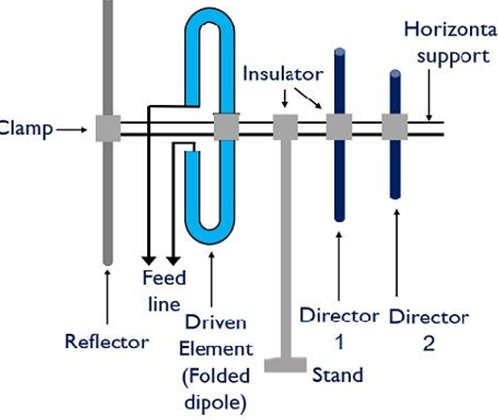The Yagi antenna or aerial sometimes called the Yagi-Uda antenna is widely used for broadcast, domestic and commercial radio communications applications where gain and directivity are required from an RF antenna design.
- The yagi uda antenna was invented in 1926 by Shintaro Uda of Tohoku Imperial University, Japan, with a lesser role played by his colleague Hidetsugu Yagi.
- It is a directional antenna consisting of two or more parallel resonant antenna elements in an end-fire array these elements are most often metal rods acting as half-wave dipoles.
- It consists of a single driven element connected to a radio transmitter or receiver through a transmission line.

Working of Yagi Antenna
- In the yagi uda antenna, there are 3 major elements are used that are generally a half-wave folded dipole, a reflector, and directors.
- The yagi uda antenna structure contains one driven element and a reflector while directors can be more than one.
- The yagi uda antenna arrangement is said to be an array of active and parasitic elements.
- The metallic rod acts as the active element as external feeding is provided to it using transmission lines in the dipole.
- The parasitic elements of the structure are the reflector and director.
- The parasitic elements are also metallic rods placed parallel in the line of sight orientation w.r.t the driven element.
- Although, when the dipole is excited using a transmission line then the current flows through the driven element and induces voltages in the parasitic elements.
- The elements are mounted on a center rod, that acts as horizontal support.
- The figure below represents the structure of the Yagi-Uda antenna.

Radiation Pattern of Yagi-Uda Antenna
- The given below diagram shows the radiation pattern of the Yagi-Uda antenna.
![]()
Advantages of Yagi Antenna
- High gain is achieved.
- The high directivity is achieved.
- Ease of handling and maintenance.
- Less amount of power is wasted.
- Broader coverage of frequencies.
Disadvantages of Yagi Antenna
- Prone to noise.
- Prone to atmospheric effects.
Applications of Yagi Antenna
- Mostly used for TV reception.
- Used where a single-frequency application is needed.
